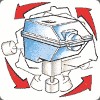The rotational moulding technology
TECHNOLOGY
The rotational moulding technology is capable of producing hollow plastic parts with unique characteristics: products which are able to meet the highest standards of quality and satisfy the most demanding requirements (double layers, sandwich, varying thicknesses, complex shapes), guaranteeing unparalleled properties.
Compared to other types of moulding, the rotational process makes it possible to produce stress-free parts with no welding or joins. As no mechanical force – apart from the rotation – is applied during the melting and moulding process, the part obtained has a uniform thickness, smudge-free colouring and excellent mechanical resistance. Furthermore, parts both small and large (up to a maximum diameter of 4.5 metres) can be manufactured, with complicated contours and professional surface finishes: imitation leather, textured, mirrored, sandblasted, shot-peened, Teflon-coated and industrial gloss.
With rotomoulding you can make a part all in one go, simplifying post-moulding processes to the utmost. Moreover, the low tooling costs represent a highly affordable solution for both large and small scale production volumes.
SUSTAINABILITY
HOW DOES IT WORK

Phase 1

Phase 2

Phase 3

Phase 4
ADVANTAGES
• One-piece parts with no welding or joins
• Stress-free parts
• Uniform wall thickness, unlike other methods such as blow-moulding
• No modifications required to tooling to change the wall thickness
• Parts can have multiple layers (foam, PA, etc…)
• Parts can be in several colours with direct transfer from the tool
• High quality graphics can be co-moulded into parts
• Relatively easy co-moulding of inserts inside parts
• Holes or missing walls can be produced during the moulding process
in parts which are normally complete
hollow bodies, without requiring subsequent machining
• Different types of product can be moulded at the same time on the same machine
• Economic viability of producing parts in limited runs
• Limited cost of tooling
• Short tool construction times
• Absolute competitiveness with other transformation technologies,
producing between 200 and 75,000 pieces per year
